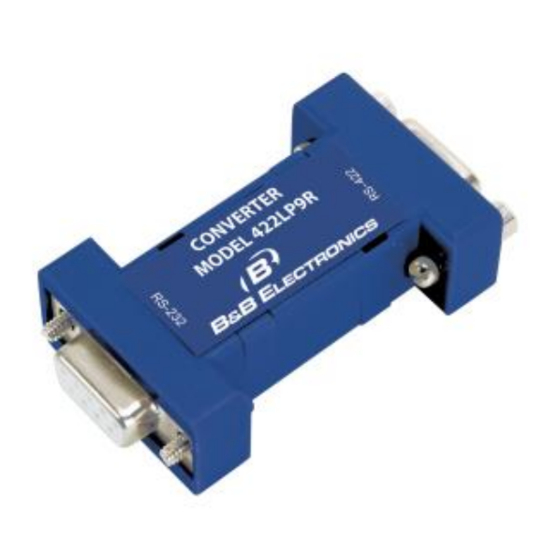
Advertisement
The 422LP9R is a port-powered two-channel RS-232 to RS-422 converter. It converts TD and RD RS-232 lines to
balanced RS-422 signals. The unit is powered from the RS-232 handshake lines DTR and RTS. One of these
handshake lines must be asserted (high) in order to power the unit (See Table 1). The RS-422 driver is enabled when
RTS is asserted. Therefore, RTS must be asserted in order to transmit data. The RS-422 receiver is always enabled. If
DTR is always asserted and the RTS is used to control the driver, the 422LP9R can be used as a RS-232 to RS-485 4-
wire converter. To insure reception, it is recommended that DTR is asserted.
In order to maximize the amount of power available to the RS-422 driver, the RS-232 handshake lines are not looped
back (tied together). As a result the following handshake lines will appear as disasserted (low): CTS, DCD, and DSR.
Care should be taken to insure that any software being used doesn't require any of these handshake lines be asserted.
If existing software requires any of the handshake lines to be asserted, you can loop back the required handshake lines
in your cable.
RTS State
DTR State
Low
Low
Low
High
High
Low
High
High
* NOTE: Low = disasserted and High = asserted
Connections
The 422LP9R can be connected in three different type of systems: RS-422 (Figure 1), four-wire RS-485 (Figure 1), and
two-wire RS-485 (Figure 2). Regardless of the system, the 422LP9R must be connected with the proper polarity. With
no data is being sent and the driver enabled, the RS-232 line should be negative and the TD(A) should be negative with
respect to TD(B). Proper operation of any RS-422 system requires the presence of a signal return path between the
signal grounds of the equipment at each end of an interconnection. This circuit reference may be established by a third
conductor connecting the common leads of devices, or it may be provided by connections in each piece of equipment to
an earth reference. When the circuit reference is provided by a third conductor, the connection between the signal
grounds and the third conductor should contain some resistance (e.g. 100 ohms) to limit circulating currents when other
ground connections are provided for safety.
Port-Powered RS-232 to
RS-422 Converter
Table 1
Functions Possible
(when port powering unit)
none
Receive
Transmit, Receive
Transmit, Receive
International Office: 707 Dayton Road PO Box 1040 Ottawa, IL 61350 USA 815-433-5100 Fax 433-5104
European Office: Westlink Commercial Park Oranmore Co. Galway Ireland +353 91 792444 Fax +353 91 792445
Model 422LP9R
www.bb-elec.com orders@bb-elec.com support@bb-elec.com
422LP9R-1712-1/2
Advertisement
Table of Contents

Subscribe to Our Youtube Channel
Summary of Contents for B&B Electronics 422LP9R
- Page 1 RTS is asserted. Therefore, RTS must be asserted in order to transmit data. The RS-422 receiver is always enabled. If DTR is always asserted and the RTS is used to control the driver, the 422LP9R can be used as a RS-232 to RS-485 4- wire converter.
-
Page 2: Specifications
422LP9R-1712-2/2 Table 2 - 422LP9R Pin Outs Signal DB-9S Pin # Transmit Data A (-) Transmit Data B (+) Receive Data A (-) Receive Data B (+) Signal Ground 4, 6 Biasing Resistors The biasing resistors for the RS-422/RS-485 receiver are 4.7K Ohm resistors. These resistors are labeled R1 and R6 (See Figure 3).















Need help?
Do you have a question about the 422LP9R and is the answer not in the manual?
Questions and answers